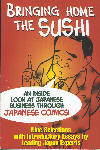|
GENRES:
Business fiction; Japanese culture
AUDIENCE:
Adults, teens; no objectionable characteristics
SYNOPSIS:
This book, a product of the lamentably defunct magazine Mangajin,
contains nine excerpts from important Japanese business comics
that appeared in that magazine. Originally intended as language-learning
exercises, these comics have been pressed into service as illustrations
of Japanese business practices and ethics, and of the behavior
of salarymen and OLs (office ladies). Although all of the comics
have been translated, they still read from right to left, and
the original Japanese text is provided at the bottom of each
page. Word balloons and important textual elements are numbered
to help us Westerners read the panels in the correct order.
All of the excerpts begin with an essay about the comic and
its importance, and the business elements depicted and how they
are true to life (or not so true) in Japan. The excerpts are
as follows:
- Human Crossroads/Ningen Kosaten: A young salaryman
fears his life is going in the same direction as that of his
father, a drunken, low-level "corporate warrior" who
was never appreciated by his bosses and who was almost never
home.
- Diary of a Fishing Freak/Tsuri-Baka Nisshi: An unambitious,
unsocial salaryman discovers the joys of fishing, and places
it above work and family. It's a fantasy for real salarymen,
tied to those twin "burdens." The excerpt also deals
with business etiquette: tatemae, or "public truth,"
versus honne, or "real truth"--i.e., bullshitting
vs. plain speaking.
- Evolution of the Office Lady/OL Shinkaron: This is
a series of strips about OL behavior. OLs do secretarial and
similar grunt work. As described in the accompanying essay, they
are usually women in their early 20s who expect to get married
in a few years and who still live with their parents, so when
they work they can spend most of their money on themselves, and
they don't expect to stay at a job for very long, so "their
OL years [are] a time of freedom and independence to enjoy life,
to travel to foreign countries, and to shop with abandon."
- Director Hira Namijiro/Torishimariyaku Hira Namijiro:
A rather unsettling encounter between "Chairman Icepocca"
of "Chrosler" automanufacturers and several business
leaders from "Daitoku Automobile Corporation" that
illustrates the difficulties that the two cultures have in understanding
the other's side in the ongoing trade dispute.
- Section Chief Kosaku Shima/Kacho Shima Kosaku: This
is an excerpt from a manga depicting "Japan's Most Famous
Salaryman," a character roughly equivalent in fame and popularity
in Japan to, say, Dick Tracy at the height of his popularity,
and with a storyline far more ambitious and complex. This excerpt
covers Shima's gaffe when he criticizes the taste of the bread
made by his company's bread machine, not knowing that the recipe
for the bread was formulated by the OLs in his new office.
- Don't Cry, Tanaka-kun!/Nakuna! Tanaka-kun: Contrary
to our Western beliefs about workaholic Japanese businesspeople,
here is Takana: a goof-off and screw-up who strives to do as
little work as possible and who takes petty revenge on his superiors
whenever possible.
- Notes from the Frantic World of Sales/Eigyo Tenteko Nisshi:
High-powered sales hijinks. Imagine a whole roomful of salesmen
yelling "Yeah!! Sell!! One appliance sold is one appliance's
worth of happiness!"
- I'm #1!/Toppu wa Ore da!: Featuring a very unusual
automobile sales manager: a woman. She uses her sex in her work
to great advantage, because her (male) clients are thrown off
their guard by her gender and her good looks.
- Salaryman Seminar/Sarariiman Senka: The gender gap
between older and younger salarymen.
Besides the essays that begin each excerpt, there are also
profiles of the essayists and all the writers and illustrators
of the various manga; a short glossary of terms; and a preface.
EVALUATION:
This work is both entertaining and highly frustrating--entertaining
because these are unusual and well-done comics, and frustrating
because they're merely excerpts from much, much longer works,
and we're not likely to see any more translations from them because
there probably isn't much of a market for them in the Western
world. But even so truncated, they offer a glimpse into a business
world that is very different from the one that U.S. readers are
familiar with. Behaviors that U.S. readers would find insulting
or demeaning, such as bowing to superiors or sexual harrassment,
are part of the working landscape. If one doesn't understand
what motivates OLs, their situation seems outrageously subservient.
The kind of "my job is my life" attitude found in Section
Chief Kosaku Shima tends to be ridiculed or looked upon with
distaste in the Western world, and Hira's defense of his bosses
(in Director Hira Namijiro) when they haven't treated
him well is simply unfathomable. On the other hand, slackers
and goof-offs can be found everywhere, and certain forms of office
politics are obviously universal! And the essays are almost universally
interesting and informative on both the comics and their meaning
to the Japanese business world, and the Japanese business world
itself.
The artistic styles range from cartoony-crude to highly realistic;
there's little of the flashiness of more "typical"
translated manga. Of course, the subject matter hardly demands
it.
The convention of reading the panels and word balloons from
right to left is awkward but can be forgiven given the original
language-teaching purpose of these comics--as opposed to the
merely "symbolic" use of right-to-left panels in the
new publication of Dragon Ball. Also, the editor and translators
didn't want to alter the comics in any significant way, and they
felt that the right-to-left convention was a worthwhile compromise.
One thing that I found irksome was the relatively limited utility
of the table of contents; the chapter headings provide neither
artist nor writer. Also, translators for the various comics are
not listed at all. I can't tell whether these are the original
translations from Mangajin or whether the comics were
retranslated for this book.
Bringing Home the Sushi is highly recommended for those
interested in Japanese culture and business, and for those who
want a peek at manga that would be considered nonstandard in
the US. It's not a terrific "pure read" because of
the excerpted nature of the comics, but it's certainly entertaining.
Oh, if only someone was interested enough to translate a full
volume or two of these stories! |



